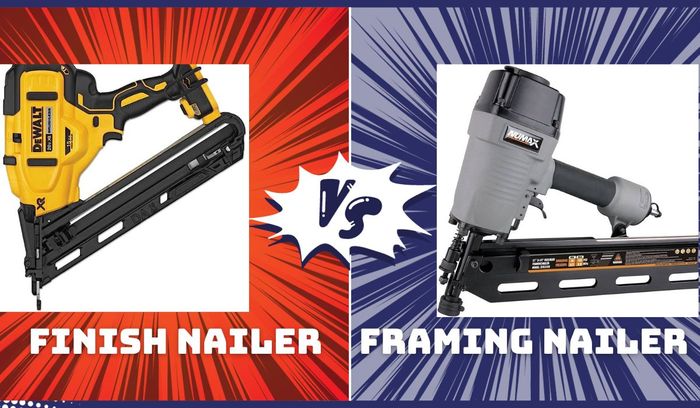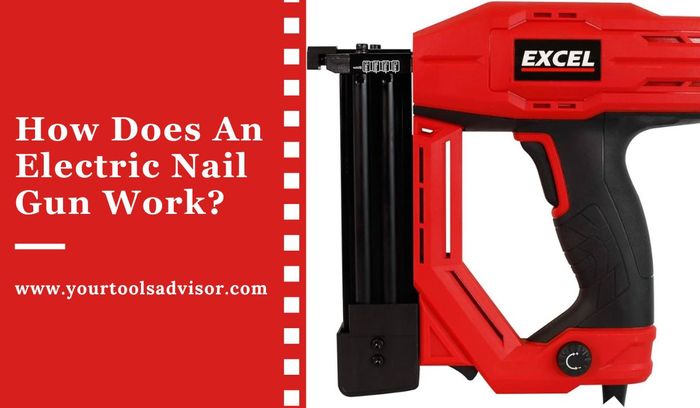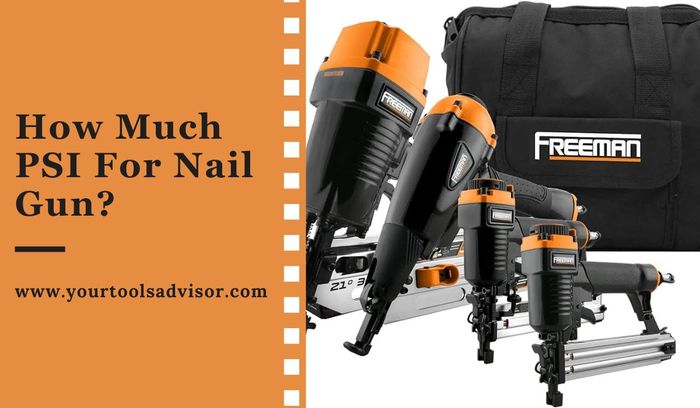When it comes to woodworking and construction projects, having the right tools can make all the difference in achieving professional-grade results.
Two essential tools in any carpenter or DIY enthusiast’s arsenal are the Finish Nailer and the Framing Nailer.
While both serve crucial roles in different stages of a project, understanding their unique features, capabilities, and ideal applications is key to ensuring success.
At the same time, understanding the differences between these two types of nail guns is crucial for choosing the right tool for the job.
In this comprehensive guide, we will compare finish nailers and framing nailers, exploring their unique characteristics, functions, and the specific tasks they are most suitable for.
Whether you are a professional contractor or a DIY enthusiast, having a clear understanding of these nailers’ capabilities will help you make informed decisions and achieve excellent results in your projects.
So let’s dive in and explore the differences between finish nailers and framing nailers…
What Is A Finish Nailer?
A finish nailer is a specialized power tool designed for driving finish nails into various materials, typically wood. It is an essential tool for carpenters, woodworkers, and DIY enthusiasts looking to achieve a clean and professional finish in their projects.
Unlike framing nailers, which are used for heavier construction tasks, a finish nailer is designed for more delicate and precise work. It is equipped with a thinner gauge and smaller head nails, which leave behind smaller, less noticeable holes in the material. This makes it ideal for applications where aesthetics and a polished final appearance are crucial, such as installing trim, molding, crown molding, baseboards, and other decorative elements.
What Is A Finish Nailer Used For?
Finish nailers are highly recommended for a range of finishing tasks in woodworking and carpentry. They excel in tasks where a strong bond is needed but without the risk of splitting the wood or leaving unsightly marks. This makes them ideal for jobs like attaching window and door casings, securing cabinetry and furniture components, and affixing decorative elements to surfaces.
Additionally, finish nailers are often preferred for tasks like installing hardwood floors, as they can secure the planks securely without causing any undue damage. The precision and finesse provided by a finish nailer make it an indispensable tool for anyone looking to achieve a refined and professional finish in their woodworking projects.
Finish nailers are more preferable for the following list of jobs:
- Installing trim and molding
- Attaching baseboards and crown molding
- Cabinetry assembly and installation
- Building furniture
- Securing paneling and wainscoting
- Installing hardwood flooring
- Attaching window and door casings
- Fixing beadboard and other decorative elements
- Creating custom cabinetry and built-ins
- Crafting intricate woodworking projects
Why Should You Choose A Finish Nailer?
A finish nailer is an indispensable tool for any serious DIY enthusiast or professional carpenter. Its precision and power make it the ideal choice for a wide range of woodworking projects, especially those involving delicate or intricate finish work.
Unlike bulkier framing nailers that use larger, more conspicuous nails, finish nailers employ smaller gauge nails with a narrower head, leaving behind smaller, less noticeable holes in the wood. This makes them perfect for applications where aesthetics matter, such as crown molding installation, baseboards, trim work, and cabinetry.
For example, when installing crown molding in a room, using a finish nailer ensures a clean and seamless finish, with nails sinking flush into the wood without causing any damage to the delicate molding profiles.
Furthermore, a finish nailer provides superior holding power compared to traditional hammer and nail methods. The nails it uses are designed to grip firmly and securely, preventing any potential wobbling or loosening over time. This is crucial for ensuring the longevity and stability of your woodworking projects.
Take, for instance, the assembly of a custom-made bookshelf. By using a finish nailer, you can confidently attach the shelves to the sides without the risk of structural compromise, guaranteeing a sturdy and reliable piece of furniture that will withstand the test of time.
In essence, a finish nailer streamlines the process, delivering professional-quality results while saving both time and effort.
Finish Nailer Pros and Cons
Pros
- Precision and Neat Finish
- Speed and Efficiency
- Reduced Risk of Surface Damage
- Versatility
- Increased Productivity
Cons
- Limited Nail Length
- Cost and Maintenance
What Is A Framing nailer?
A framing nailer is a power tool used in construction to quickly and efficiently drive nails into wood or other materials. It is designed specifically for tasks that involve framing, such as building walls, roofs, or other structural elements.
The nailer uses compressed air, gas, or electricity to propel nails into the material, saving time and effort compared to manual hammering. This tool is a staple in carpentry and construction work, allowing for precise and consistent fastening of large pieces of lumber.
What Is A Framing Nailer Used For?
Framing nailers are powerful pneumatic or electric tools designed for efficiently driving large nails (known as “framing nails”) into various types of construction materials, particularly wood. They are widely used in carpentry and construction projects to securely fasten together structural elements such as studs, joists, and beams.
Unlike traditional hammer and nail methods, framing nailers provide a quicker and more precise way to join pieces of lumber, significantly increasing productivity on job sites. This tool is indispensable in tasks like framing houses, building decks, constructing fences, and other projects that require robust and reliable connections between wooden components.
Moreover, framing nailers come in different styles, including coil nailers and strip nailers, each with its unique magazine design for holding nails. They are typically equipped with depth adjustment settings, allowing users to control how deeply the nails are driven into the material. This feature is particularly useful in preventing over-penetration or under-driving, ensuring that the fasteners hold securely without causing any structural damage.
Overall, framing nailers are an essential tool for professional carpenters, contractors, and DIY enthusiasts looking to tackle large-scale construction projects efficiently and with precision.
A framing nailer is more preferable for the following list of jobs:
- Residential and commercial construction.
- Wood framing for concrete work.
- Sheathing and Siding Installation
- Custom Furniture and Cabinetry
- Paneling and Wainscoting Installation
Framing Nailer Pros and Cons
Pros
- Efficiency
- Precision
- Reduced Physical Strain
- Versatility
- Increased Productivity
Cons
- Cost
- Safety Concerns
Finish Nailer Vs Framing Nailer
A finish nailer and a framing nailer are both essential tools in carpentry and woodworking, but they serve distinct purposes in the construction process. A finish nailer, as the name suggests, is primarily used for finishing touches on a project. It is designed to drive smaller, thinner gauge nails with precision, making it ideal for tasks like attaching trim, moldings, and delicate woodwork.
The nails used in a finish nailer leave minimal visible marks, which is crucial for achieving a polished, professional look. Due to its narrower gauge nails, a finish nailer is not suitable for heavy-duty framing tasks, as it lacks the power needed to penetrate thicker and denser materials commonly used in structural framing.
On the other hand, a framing nailer is built for heavy-duty tasks involving structural framing and rough carpentry work. It is designed to drive larger, heavier gauge nails with significant force, ensuring they securely attach beams, joists, and other load-bearing elements.
The framing nailer’s power and depth of penetration are crucial for tackling dense materials like hardwoods and engineered lumber. While it may leave more noticeable nail marks, this is generally acceptable in structural applications where strength and stability take precedence over aesthetics.
In summary, the choice between a finish nailer and a framing nailer depends on the specific task at hand, with the former being ideal for precision work, and the latter for robust, load-bearing applications.
Differences In Functionality
A finish nailer and a framing nailer are both powerful tools in the world of carpentry, but they serve different purposes and have their distinct features.
| Finish Nailer | Framing Nailer |
|---|---|
| Designed for precision and detail work | Specifically built for heavy-duty and structural projects |
| Ideal for installing crown molding, baseboards, and trimming | Perfect for framing, sheathing, fencing, and decking |
| Uses 16-gauge to 23-gauge nails for delicate and smaller applications | Utilizes 10-gauge to 12-gauge nails for structural support and heavy-duty fastening |
| Smaller size and lighter in weight | Bulkier and heavier in comparison |
| Creates a more refined and seamless finish | Offers greater holding strength and durability |
In summary, a finish nailer is designed for intricate woodworking projects, providing precision and a polished finish, whereas a framing nailer is built for heavy-duty construction tasks, offering strength and structural integrity.
Power And Nail Types
Finish nailers and framing nailers are both powerful tools used in construction and woodworking projects.
However, they differ in terms of their power source and the types of nails they use.
| Nailer | Power Source | Nail Types |
|---|---|---|
| Finish Nailer | Pneumatic or Electric | 15 or 16 gauge nails |
| Framing Nailer | Pneumatic or Cordless | 10 or 12 gauge nails |
Finish nailers can be powered by either a pneumatic compressor or an electric motor, providing consistent power for driving smaller nails with precision. They are primarily used for finishing, trim work, and molding installation.
Framing nailers, on the other hand, commonly rely on a pneumatic compressor or a cordless battery for power. These nailers are designed to handle larger and more robust 10 or 12 gauge nails, making them ideal for framing, sheathing, and other heavy-duty construction applications.
Understanding the power source and nail types specific to each nailer is crucial in choosing the right tool for your project and achieving optimal results.
Applications And Project Types
A finish nailer is designed for more delicate and detailed work, making it ideal for a variety of woodworking projects. It is commonly used for tasks such as installing baseboards, trim, crown molding, and other decorative moldings. With its smaller, thinner nails, a finish nailer ensures a clean and professional finish without the risk of splitting the wood.
On the other hand, a framing nailer is designed for heavy-duty construction projects. It is commonly used for tasks like framing walls, constructing decks, and building outdoor structures. With its larger, thicker nails, a framing nailer provides the strength and stability needed to handle these types of projects. It is efficient for quickly attaching framing materials together.
In conclusion, while a finish nailer is suitable for smaller, detailed projects, a framing nailer is preferred for larger construction tasks.
Always try to consider the nature and scale of your project to determine which type of nailer will best meet your needs.
FAQs On Finish Nailer Vs Framing Nailer
What is the difference between framing nails and finishing nails?
Framing nails are designed for structural work, such as framing houses, and are larger and stronger. Finishing nails are smaller and have a more delicate finish, making them suitable for tasks like attaching trim or molding.
Can A Finish Nailer Be Used For Framing?
No, a finish nailer is not suitable for framing tasks. It uses shorter, thinner nails that lack the strength and length required for structural framing projects. For framing, a framing nailer is the recommended tool as it can handle longer and thicker nails to provide the necessary stability and durability.
When Should I Use A Finish Nailer Instead Of A Framing Nailer?
A finish nailer is the go-to tool when you need precise, clean and invisible nail holes in delicate materials such as trim, crown molding or cabinetry. It is ideal for attaching lightweight materials without causing damage or splitting. For larger, load-bearing projects like framing or sheathing, a framing nailer is the more suitable option.
Are Finish Nailers And Framing Nailers Interchangeable?
While both types of nailers are used in woodworking projects, they are not interchangeable. Each serves a specific purpose: a finish nailer for detailed and delicate work, and a framing nailer for heavy-duty structural tasks. Using the wrong nailer can result in weak joints, damage to materials, or even injury.
Conclusion
To sum it up, while both finish nailers and framing nailers have their own unique purposes, it is crucial to understand the specific requirements of your project. Choosing the right nailer can greatly impact the quality and efficiency of your work.
By considering factors such as nail size, project type, and desired finish, you can make an informed decision that will ultimately lead to better results.
So, evaluate your needs carefully and select the appropriate nailer for the task at hand.
Happy nailing!





Leave a Reply